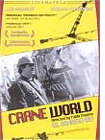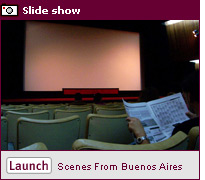Scenes From Buenos Aires
And that, paradoxically, was exactly what made it so important. For the previous decade or so, Argentine cinema had been largely filled with didactic and self-important movies, many of them having to do with the military dictatorship that ruled Argentina in the 1970s and early '80s. After Rapado, though, a host of new filmmakers took Rejtman's lead and began making movies about the streets of Buenos Aires and the pleasures and problems of everyday life. In 1997, Adrián Caetano and Bruno Stagnaro made Pizza, Birra, Faso, a sort of low-rent Mean Streets, about young street thugs looking to make that proverbial big score. The movie had sound you could barely hear, relied on vivid handheld camerawork, and was invested in the life of the street: casual crime and people waiting in line for work. It was made with non-actors. It was also the first time that many young Argentines had seen something resembling their lives onscreen. Two years later, Pablo Trapero made Mundo Grúa, an oddly elegant film about El Rulo, an overweight, middle-aged ex-musician struggling to stay afloat in an economy that seemed to have no place for him. Filmed in black and white, it veers sharply from the comedic to the tragic, and in El Rulo, it showcases a captivating character: a good man given to strange lyrical flights who nonetheless finds himself unable to keep a job or to take care of the people he loves in the way he wants.

To a foreigner, the first thing that's noticeable about these movies is what isn't in them: namely, all the stereotypical things one associates with Argentina. There's no mention of the tango, psychoanalysis, the mothers of the desaparecidos, or the military dictatorship that ruled Argentina between 1976 and 1983; even soccer makes only an occasional appearance. Argentina's economic problems (the country endured hyperinflation in the late 1980s, then a dramatic economic restructuring in the 1990s that knocked hundreds of thousands of people out of work, before defaulting on its foreign debt in 2001) are inescapable in these films, but they're the backdrop against which the characters live, rather than a political issue they comment on explicitly. The characters in these movies—and those they inspired, as the number of new Argentine films exploded after 1997—were resolutely ordinary-looking, stripped of all glamour (far more so than in American or French independent cinema). The storylines often lacked conventional drama, in the Hollywood sense: It's close to impossible, for instance, to think of an American film like Mundo Grúa, where the central conflict is whether or not the main character will be able to find and hold on to a job. There were echoes in these movies of Italian neo-realism and the early New Wave. And they were (and are), almost without exception, remarkably engaging (rather than daunting), filled with energy and driven by a radical attentiveness to detail and a powerfully unsentimental spirit.
As we talked with directors and critics, it quickly became clear that what's taken place over the past decade has been nothing less than the resurrection of an entire industry. Argentina had a vibrant independent cinema in the 1960s, but it was essentially destroyed in the 1970s with the advent of military rule. (Some directors went into exile, others were forced to stop making movies, and a few, like director Raymundo Gleyzer, were sent to concentration camps from which they never emerged.) In the place of real movies, Argentines got propaganda. Pablo Suarez, a critic and translator who writes about movies for Argentine and U.S. journals, put it eloquently: "During the dictatorship, they showed us absurd movies with titles like The Blue Policeman in Action and Top Spies," he said. "They were trying to convince us that we lived in the best of all worlds; the films were bad in all respects."
With the arrival of democracy, life in Argentina improved, but movies didn't. "The people making movies after the dictatorship fell wanted to give a testimony to what had happened. But they did it by making what you could call 'filmed theater.' The dialogue was declamatory and artificial, even though they wanted it to sound natural," Suarez explained over lunch. "The characters were characters that only existed in the cinema and couldn't exist in real life. The staging was boring: Everything was shot/reverse shot. All they were concerned about was content, content, content. There was no interest in style. And even the content was too simplistic, too one-sided. Everyone was either bad or good, and everything was spelled out for us as if we were dimwits. It just felt a long way from the things most of us were really thinking about and really worried about. These movies just had nothing to do with what it felt like to live in a city, what we were dealing with in our lives and our jobs and our relationships." The one example of these movies that Americans may have seen is Luis Puenzo's The Official Story, a stately melodrama about the children of the disappeared, which won the Oscar for best foreign-language film in 1986.
Argentina's recent political history has been so tumultuous that it might seem that the only way to make serious movies would be to engage seriously with the past. In fact, the opposite was true.What had to be done was to treat politics as almost beside the point. Instead of making movies that hammered home didactic messages about the dangers of tyranny or the limits of capitalism, the first wave of films in the New Argentine Cinema sought simply (though not simplistically) to show the world as it was and to putpeople and events on screen that weren't previously considered worthy of notice. "All of a sudden, we started seeing ourselves on the big screen. You could see people not being able to get a job, trying to fall in love when everyone seems to be engaged already. Ordinary neuroses could be onscreen."
They were also onscreen in a new way: The films rejected not just the subject matter of older films but their reliance on conventional narrative. They move with jagged rhythms. Scenes last longer than you expect them to or are cut off unexpectedly. Rather than paint out a message, as Suarez put it, "They would not spell out anything." This was, of course, a political message in and of itself. But it was a considerably more subtle political message than the one found in a movie like The Official Story.
The catch, of course, is that life in Buenos Aires is not really like life in other major cities. If you're from a big city, Buenos Aires will seem remarkably congenial, and in some important ways remarkably like home. (When I told Suarez that Buenos Aires—with its all-night energy and its commercial vibrancy—reminded me of New York, he said that everyone who comes to Buenos Aires says it reminds him of the city they live in.) But history has made sure that everyday life in B.A. is different from that in other cities in a way that you can't quite escape. This is, after all, a city that saw its government torture and murder tens of thousands of people. It's a city whose citizens saw 80 percent of their wealth vanish overnight in 2001, when Argentina defaulted on its debt and was forced to devalue its currency. And it's a city where, as Suarez put it, everyone has to have three jobs to survive.
